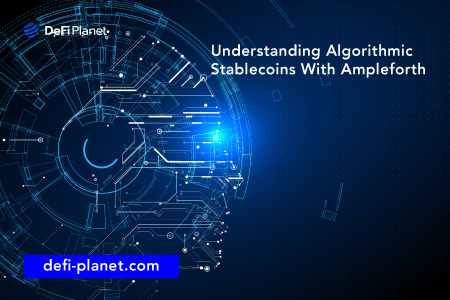Last updated on July 18th, 2023 at 01:15 pm
Stablecoins designed to maintain their one-to-one peg to a real-world asset like fiat currency such as the US Dollar, or Gold is the backbone of the crypto ecosystem. In terms of bringing much-needed liquidity to the ecosystem, stablecoins stand out in the cryptocurrency world. This is because, for trading and lending purposes in crypto, stablecoins are the asset of choice.
Over the years, stablecoins have evolved from simple asset-backed coins designed into cryptocurrencies that offer unique features and functionalities.
This article will talk about stablecoins focusing on the most trending type of stablecoins, i.e., algorithmic stablecoins.
We will discuss how algorithmic stablecoins are different from the stablecoin categories that we’ve known till now. Moreover, we’ll take a closer look at Ampleforth, an algorithmic stablecoin, and try to understand its mechanism and usability.
Let’s dive in!
What Is A Stablecoin?
A stablecoin is a cryptocurrency pegged to a ‘stable asset’, typically a real-world asset on a 1:1 ratio. Backed by these assets, each stablecoins holds a reserve of whatever asset is backing it. For example, USDC is a stablecoin pegged to the US dollar, and thus Circle, the company behind USDC, holds US dollars in reserve. This is done to ensure that the price of the stablecoin remains non-volatile in all market conditions and maintains its peg. Because of this price stability, stablecoins have become the go-to asset option for traders and participants in the DeFi ecosystem for trading and lending.
The benefits of using stablecoins are as follows:
- Low volatility as they are designed to maintain their peg.
- High level of liquidity as they can be easily transferred within the crypto ecosystem and between crypto markets and fiat markets.
- Stablecoins can be used as a safe-haven asset to protect your wealth during crypto market downturns.
- By lending your stablecoins to CeFi companies or on DeFi lending platforms, you can earn interest on your holding while removing the risk of volatility.
The Evolution Of Stablecoins
Now that we know what stablecoins are, let’s look at some of the different types of stablecoins.
- Fiat-backed stablecoins – These stablecoins are designed to maintain their peg with fiat currencies and typically hold a fiat reserve on a 1:1 basis. Doing so allows users to exchange stablecoins for fiat currencies and vice versa without any problems. USDT and USDC are popular fiat-backed stablecoins backed by, as the name suggests, the US dollar. Moreover, most exchanges like Binance and Gemini offer their own dollar-backed stablecoins called BUSD and GUSD, respectively, for trading on their platform.
- Commodity-backed stablecoins – Just like commodities help investors diversify in traditional financial markets, they offer crypto investors an alternative to fiat-backed stablecoins and thus diversify their holdings. While many different commodities can be used to back a stablecoin, Gold is considered the most reliable asset as it has been a safe-haven asset for years. Paxos Gold or PAXG is a stablecoin that is backed by Gold.
- Crypto-backed stablecoins – To create a rustless stablecoin that wasn’t connected with the real world, crypto-backed stablecoins like DAI were developed. Such stablecoins reserve the crypto funds of users as reserve collateral and are typically overcollateralized to protect them from collateral price crashes.
- Algorithmic stablecoins – Algorithmic stablecoins are both decentralized and trustless as no regulatory body is responsible for maintaining them. Such stablecoins are designed to protect their peg by using an algorithm that issues more coins (increases supply) when price increases (demand increases) and buys them off the market (decreases supply) when the price falls (demand decreases). The concept of algorithmic stablecoins was created to offer inflation-proof cryptocurrencies that could be used as stable collaterals in the crypto ecosystem. Examples of algorithmic stablecoins include Ampleforth (AMPL), Empty Set Dollar (ESD), etc.
What Is Ampleforth?
Originally called Fragments, Ampleforth was launched in 2018 and is known as a first-generation algorithmic stablecoin.
The founders of Ampleforth, Evan Kuo, and Brandon lles, envisioned it to be used to issue crypto-assets to gig economy workers. However, with the growing popularity of Ampleforth, it is seen as an inflation-proof cryptocurrency by crypto enthusiasts. This is because, as opposed to other stablecoins, the mission of Ampleforth is not just to maintain its peg to the US dollar and be as close to $1 as possible. Instead, it is intended to be an asset that offers protection against inflation in addition to the protection against the volatility of major crypto assets such as Bitcoin. Thus, the aim of Ampleforth is not necessarily to preserve its value in terms of dollars but to help AMPL holders maintain their purchasing power irrespective of market fluctuations.
Ampleforth Vs Stablecoins
Just like other stablecoins, Ampleforth helps users maintain price stability. However, the approach it takes to do so is different from other stablecoins.
While most stablecoins rely on deposits or issuance and redeeming debt to maintain their peg, Ampleforth is programmed to adjust its supply every 24 hours through a process called rebasing. This means that AMPL token-holders witness the balance of their AMPL holdings in their wallets change every day at 2:00 UTC. Thus, AMPL’s supply adjusts in the following three ways:
- Expansion – When the price of AMPL is greater than $1 at the end of the day, token holders are rewarded with new AMPL tokens.
- Contraction – When the price of AMPL is less than $1 at the end of the day, AMPL tokens are removed from the supply, and token holders see their holdings reduced.
- Equilibrium – When the price of AMPL is $1 at the end of the day, the supply remains the same.
Thus, by contracting and expanding in relation to its price at the end of the day, AMPL offers an algorithmic stablecoin that is elastic and non-dilutive. This means that while the supply changes according to the price, token holders retain the same proportion of the overall supply before the rebasing. For instance, if you held 2% of all AMPL supply before rebasing, you will still have the same percentage of AMPL after the rebasing.
Ampleforth Use Cases
Let’s take a look at some of the use cases of Ampleforth:
- Use in stable contracts – As Ampleforth is designed to maintain its supply elasticity to protect against dilution and stabilize its value, it can be used in stable contracts. This can be done using other crypto-assets like Bitcoin, but it is believed that the price volatility of such assets would make the contracts unstable. Since Ampleforth is designed to have a predictable value, it is better for use in stable contracts.
- Diversification – As the AMPL token is not highly correlated with other crypto assets such as BTC and ETH, crypto investors use it to diversify their portfolios or hedge against market volatility.
- Collateral in DeFi – As AMPL is stable, it offers an efficient form of collateral used in DeFi protocols.
In Conclusion…
- Stablecoins are the backbone of the crypto ecosystem, and algorithmic stablecoins like Ampleforth offer unique features in addition to simply maintaining their value. In theory, algorithmic stablecoins are precisely what the crypto market needs – a decentralized and trustless cryptocurrency designed to maintain its value. However, in practice, many algorithmic stablecoins have failed, resulting in users getting rekt. Having said that, algorithmic stablecoins is a concept that is still in its nascent stage, and despite its challenges, they are a step in the right direction for stablecoins.
So what do you think about algorithmic stablecoins like Ampleforth? Do you think they are the future of stable coins in the crypto ecosystem?
Comment below and let us know what you think!
If you would like to read more articles like this, follow DeFi Planet on Twitter and LinkedIn.




















